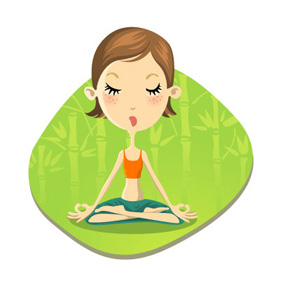Meditation Guide: The Basics of Meditation - Purpose & Practice
 The dictionary defines the verb "to meditate" as an action of reflection, or contemplation. It gives the description of both Buddhism and Hinduism as using meditation to "train, calm, or empty the mind, often by achieving an altered state, as by focusing on a single object." And it gives a further example of meditation being used to engage in devotional contemplation, especially prayer.
The dictionary defines the verb "to meditate" as an action of reflection, or contemplation. It gives the description of both Buddhism and Hinduism as using meditation to "train, calm, or empty the mind, often by achieving an altered state, as by focusing on a single object." And it gives a further example of meditation being used to engage in devotional contemplation, especially prayer.
These broad definitions tell us that meditation is both practical and accessible for everyone, it isn't bound by culture or religion and it isn't hard to do.
Meditation is simply the act of quiet contemplation. A withdrawal of the senses from their constant external bombardment of information and a reigning in of the mind, by quieting it's chatter and calling it to focus on one singular thing. That thing might be our breath, a candle flame, a single word, or a devotional prayer, or mantra.
Purpose: Meditation as an Act of Singular Focus
This singular contemplation relaxes our mind and slows our thoughts, it gives true mental rest and relief from stress and anxiety. The choices of meditation techniques are endless, but they need not overwhelm us for they can all be defined simply by their object of focus.
To focus on the breath is calming to the mind. It reigns in our swirling thoughts and emotions and is a genuinely healing and deeply relaxing experience. It's practical and beneficial to both the mind and the body. But it's not spiritual, because it's focus is the breath and breath is not a matter for spiritual pursuit.
To focus on a prayer, or mantra, or the Holy Names of God, that is spiritual meditation because the object of contemplation is transcendental. My spiritual master taught me that if you want to know God you have to sit down and listen out for Him. He told us to read scripture, or chant quietly and stop rushing around so we can hear Him.
So the choice is ours, we can meditate on a flame for improving our eyesight and stilling the mind, on our breath for health and peace of mind, we can use detached contemplation for emotional release, and we can chant prayerfully for spiritual mediation. We are not limited to one type, we can try one or many depending on our needs. Personally, my primary focus is on japa meditation (chanting the names of God on beads), but I also frequently use pranayama breath control for clearing my mind and for my health, I also practice other techniques if I'm stressed or preparing for sleep, and I recently learned one method of meditation from Ayurvedic teacher Dr Vasant Lad that is excellent for stepping back from emotions and becoming quickly clear minded and calm.
Practice: A Quick Look at the How To of Meditation
Breathing: When we slow our breath, we slow our thoughts. Our breath directly and powerfully affects our state of mind, so whatever form of meditation is being practised it is helpful to breath steadily and slowly. That way it's easier to reign in our thoughts and enter into a contemplative state.
Posture: It's not necessary to adopt a specific posture (or asana to meditate). Sometimes I do, sometimes I don't. There are times when I like to light candles and sit on a mat before my altar in the early morning and chant, and other times when you'll find me in a chair, or cross legged on my bed practising some focused breathing. So long as you keep your back fairly straight to allow free flow of energy you can sit however you feel comfortable.
Concentration: This is the biggest challenge in meditation. We can't actually stop our thoughts or gain complete control over our minds. We can slow thoughts down, and we can turn down the chatter, but we can't turn it off. So meditation becomes the practice of repeatedly drawing the mind back to the object of focus. We have to learn to constantly remind ourselves to focus on our breath, our mantra, whatever the object of focus is, you need to practice bringing your mind back to it over and over again.
When we practice bringing the mind back to that one singular point of focus we are situated perfectly in the present moment. We are mentally free from our history and any concerns over our future. We are fully present in that moment with that one singular object of focus and that is meditation.